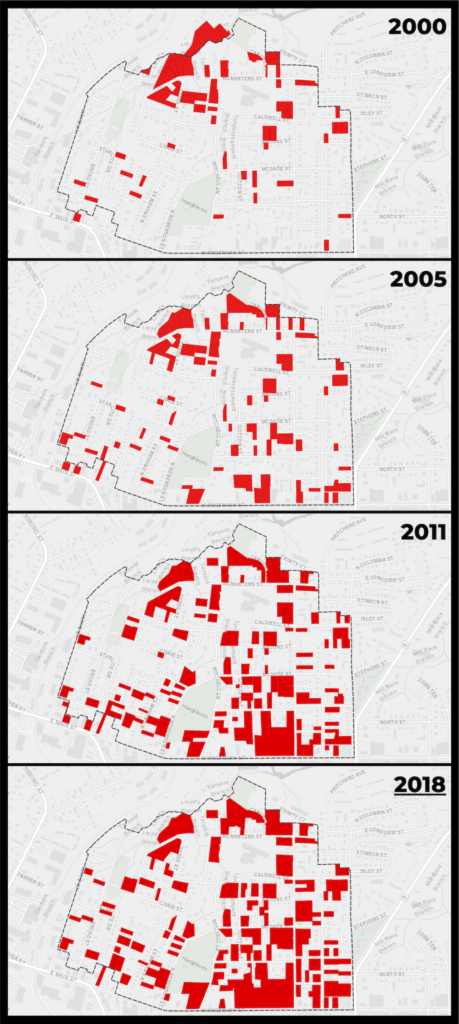
Investor-Owned Properties in Northside
The red shading shows investor-owned properties in Northside. The increasing displacement of longtime Northside residents led to the creation of the Northside Neighborhood Initiative.
Beginning in 2017, the Jackson Center has conducted a Northside Census every two years to measure the impact of its housing initiatives in the Northside neighborhood. The Northside Census measures neighborhood demographics, student versus non-student households, racial and ethnic diversity, and longtime residents’ experiences with student neighbors. The Northside Census informs the ongoing work and goals of the Northside Neighborhood Initiative.
Background
The Northside neighborhood, historically the largest African American community in Chapel Hill, has been experiencing a loss of homeownership for several decades and an increasing demand for student rentals. Residents, community organizations, and Town of Chapel Hill staff and elected officials have worked together for over 25 years on policies, regulations, and community development strategies to address the challenges the community is facing. Residents cite concerns that investors are expanding old homes or building new ones designed specifically to house multiple students and express a desire to maintain the family atmosphere of the neighborhoods through the development of rental and homeownership opportunities that are affordable to families.
The Jackson Center works toward housing justice in a number of ways:
Northside Neighborhood Initiative: The Northside Neighborhood Initiative is a broad-based partnership effort to control the dirt in Northside, have neighbors determine the future of properties, and preserve the future of this diverse, family-friendly neighborhood. The Northside neighborhood has organized to encourage responsible development that meets the needs of the community.
Student Engagement: The rapid “studentification” of the historically Black Northside, Pine Knolls, and Tin Top neighborhoods in the early 2000s saw an influx of student residents who were unaware of the history and values of the Northside neighborhood. Thus began a collaboration between the Jackson Center, the University of North Carolina at Chapel Hill, local municipalities, and other community partners to transform students’ relationships with Northside. Today, students experience the rich history, values, and traditions of the Northside, Pine Knolls, and Tin Top neighborhoods by engaging as partners in service and advocacy for the community.
Affordable Housing: For the last fifteen years or more, Northside neighbors, many of whom have lived here for decades, have faced rapidly increasing property taxes, making it increasingly difficult for long-term neighbors to stay rooted in our community. Through a process of community-first organizing, we engage a robust set of communication and organizing tools that brings neighbors and other stakeholders into active and realistic planning discussions focused on change that enhances community and regional goals.
Northside Census Findings
Every two years, we update the Northside Census and identify key findings that inform our Northside Neighborhood Initiative (NNI) work. Volunteers go door-to-door, collecting data from a representative sample of hundreds of Northside homes. This data is anonymized, aggregated, and analyzed to understand changes in demographic information and impact/success of the Northside Neighborhood Initiative.
Data collection for the 2023 Northside Census is underway. Below, we share key findings from our most recent completed Northside Census.
2021 Northside Census Key Findings
- Land bank efforts have stabilized the “studentification” of Northside. The student vs. non-student balance in the neighborhood have both stayed relatively stable since the first Northside Census in 2017. This is strong evidence for the success of the NNI.
- The racial and ethnic diversity amongst residents of homes that have passed through the NNI land bank is more reflective of the historical make-up of the neighborhood than any other segment of housing other than public housing, which speaks to the success of the NNI.
- The student population in the neighborhood is getting more diverse and less white. More student households are households of color (Black, Latinx, Asian, and multiracial) in 2021 than in 2019, but there are hardly any majority-Black student households.
- The percentage of Black, non-student residents is declining. There are more white, non-student residents and majority-white, non-student households compared with the 2019 census. This increase is just within the margin of error but is concerning if the one of the NNI goals is to attract new residents who reflect the existing racial and ethnic diversity of the neighborhood.
Detailed findings are shared with the Northside Compass Group to help inform their decision-making about future Northside Neighborhood Initiatives goals and efforts.
Support the Northside Census
We collect data for the Northside Census through door-to-door canvassing of hundreds of Northside houses. We could not do this without the effort of countless volunteers. Volunteers also report that walking through the neighborhood and talking to residents is one of the best ways to start to get to know the Northside community. View current volunteer opportunities.
